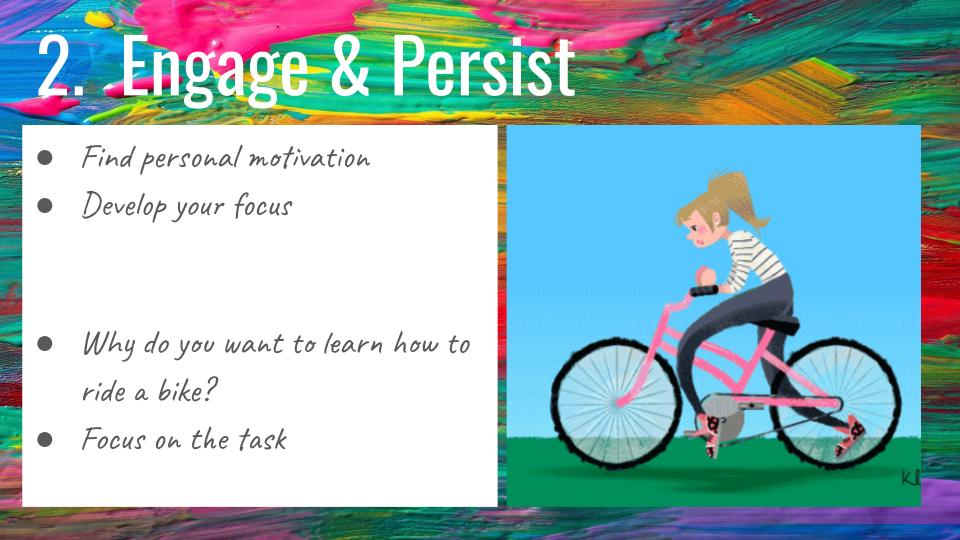

My hope for our artists is that they learn to problem solve, use mistakes and failures to grow, and discover their unique voice in order to express who they are. In the art room, we explore and experiment with a lot of different mediums and techniques.

This framework has eight components: Develop Craft, Engage and Persist, Envision, Express, Observe, Reflect, Stretch and Explore, and Understand Art Worlds. In the Centennial art room we focus on the Studio Habits of Mind to inform the processes and cultures we learn about. I believe in the process of artmaking rather than the finished product. Outside of being a teacher, I like to make art (specifically printmaking, painting, and photography), read, cook, and take care of a ridiculous amount of houseplants. We adopted a precosious beagle named June during the pandemic. I have a son who will begin second grade this year. My family and I moved back to Colorado in 2019 to be closer to family and friends. Although I am a Colorado native, I started my teaching career in 2011 in Georgia, followed by six years in North Carolina. I was born and raised in Colorado and attended K-12 schools in District 6. Hello! My name is Nicole Gilbert and I am the Art Teacher at Centennial Elementary School. Brown, Allie- Speech Language Pathologist Assistant.Aldava, Veronica- Special Education Assistant.Rivera, Brittni- Special Education Assistant.Jackson, Amanda- Special Education Assistant.Smith, Brianne- Special Education Assistant.Rogers, Tiffany-Special Education Assistant.The habits do not operate and should not be taught in a set sequence that privileges one or another over the others. Robinson, Melissa- Special Education Teacher Eight Studio Habits of Mind We present the Habits of Mind in an oval because they are non-hierarchical, so none logically comes rst or last.Najera Valdez, Griselda-Building Instructional Assistant.Moreno, Vivian-Special Education Assistant.Middleton, Ainsley-Speech Language Pathologist.

Hernandez, Rosa-Instructional Assistant.Hernandez, Janie-Special Education Assistant.Castro, Erica - Parent and Family Advocate.Barghelame, Erin-Special Education Teacher.pattern forming: combining simple elements in unexpected ways analogizing: two apparently different things share important properties or functions body thinking: thinking that occurs through sensations and awareness of muscle movement and emotion empathizing: integrating "I" and "it." "Becoming' another person, animal, plant, electron, or star dimensional thinking: interpreting "pictures" in one set of dimentions as objects in another set modeling: Higher-order thinking tool that requries combination of other thinking tools: construction (physical or intellectual) that "stands in" for the "real thing" playing: a tool that integrates use of other tools such as body thinking, modeling, empathizing, etc. imaging: "seeing" in the mind things recalled or created recognizing patterns: discovery of natural laws, structures, rhymes, rhythms, intentions. Observing: knowledge about the world acquired by paying attention to what is seen, heard, touched, smelled, tasted, or kinestheically experienced. Arts is in parenthesis here as it can easily be switched with other disciplines, like science or history. Envision: learning to picture mentally what cannot be directly observe, and imagine possible next steps in making a piece Express: learning to create works that convey an idea, feeling, or personal meaning Observe: learning to attend to visual contexts more closely than ordinary "looking" requires and thereby to see things that otherwise Reflect: learning to think and talk with others about an aspect of one's work or working process, and learning to judge one's work Stretch and Explore: learning to reach beyond one's capacities, to explore playfully without a preconceived plan, and to embrace the opportunity to Understand (Arts) Community: Learning to interact as an artist with other artists (i.e., in classrooms, in local arts organizations, and across the art field) and within the broader society. Develop Craft: learning to use tools, materials, artistic conventions and learning to care for tools, materials, and space Engage and Persist: Learning to embrace problems of relevance within the art world and/or of personal importance, to develop focus conducive to working and persevering at tasks.


 0 kommentar(er)
0 kommentar(er)
